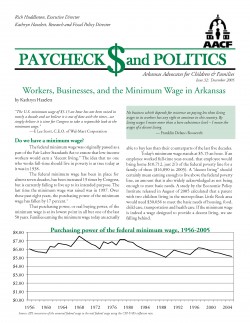
The federal minimum wage was originally passed as a part of the Fair Labor Standards Act to ensure that low-income workers would earn a “decent living.” The idea that no one who works full-time should live in poverty is as true today as it was in 1938.
The federal minimum wage has been in place for almost seven decades, has been increased 19 times by Congress, but is currently failing to live up to its intended purpose. The last time the minimum wage was raised was in 1997. Over these past eight years, the purchasing power of the minimum wage has fallen by 17 percent. That purchasing power, or real buying power, of the minimum wage is at its lowest point in all but one of the last 50 years. Families earning the minimum wage today are actually able to buy less than their counterparts of the last five decades.
Today’s minimum wage stands at $5.15 an hour. If an employee worked full-time year-round, that employee would bring home $10,712, just 2/3 of the federal poverty line for a family of three ($16,090 in 2005). A “decent living” should certainly mean earning enough to live above the federal poverty line, an amount that is also widely acknowledged as not being enough to meet basic needs. A study by the Economic Policy Institute released in August of 2005 calculated that a parent with two children living in the metropolitan Little Rock area would need $30,036 to meet the basic needs of housing, food, child care, transportation and health care. If the minimum wage is indeed a wage designed to provide a decent living, we are falling behind.
